Skateboarding appeals to a diverse range of enthusiasts, from amateur skaters to seasoned professionals. As skate parks become hubs of activity, ensuring adequate lighting is crucial for both safety and security.
Safety is a primary concern, but there are additional benefits to consider when hiring a lighting designer. For instance, LED lighting can offer significant cost savings. However, achieving the most efficient placement of these lights can be challenging without expert guidance.
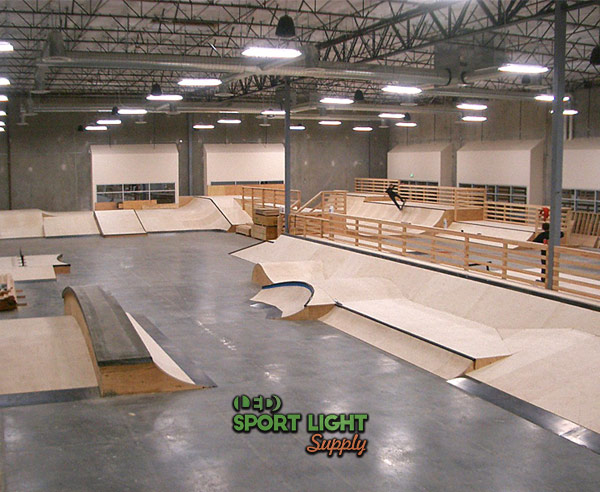
What This Guide Covers
This guide provides an overview of essential lighting standards for indoor skate parks. Each requirement is designed to address specific goals, ensuring optimal performance regardless of the park’s size or the types of ramps used.
The final section emphasizes the importance of adhering to lighting standards. While skateboarding tricks are often performed to impress, poor lighting—whether due to insufficient sunlight or artificial illumination—can increase the risk of injury.
By consulting with a professional, you can ensure that every detail is managed effectively. This not only enhances the experience for spectators and broadcasters but also improves the overall safety and functionality of the skate park.
Table of Contents
ToggleSkate Park Lighting Standards
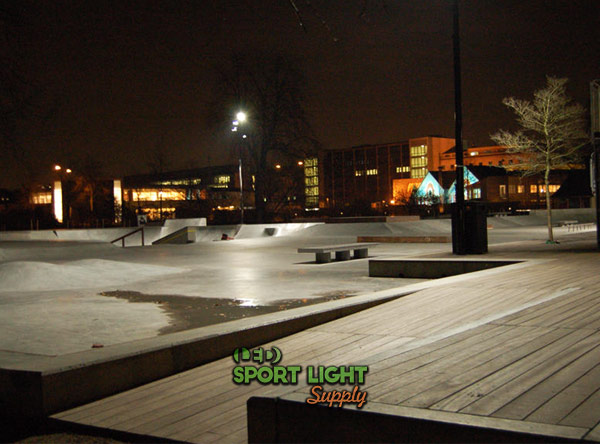
Brightness Requirements
Skate parks feature various ramps and surfaces, and their design often focuses on functionality and usability. For instance, a full pipe is designed to facilitate both speed and visibility. Proper artificial lighting is essential to ensure that shadows are minimized, and visibility is maintained across all areas of the park.
To meet these needs, it’s important to achieve the recommended lux levels for different uses:
| Use Case | Lux Range |
|---|---|
| Recreational Use | 100 to 250 lux |
| Competitions | 400 to 800 lux |
| Professional Events | 1,000 to 1,500 lux |
A lux meter is a tool that measures the illuminance in any given area. For convenience, you can use a professional lux meter or a smartphone app. Lux measures the intensity of light, and the value decreases as the distance from the light source increases.
Lighting Uniformity
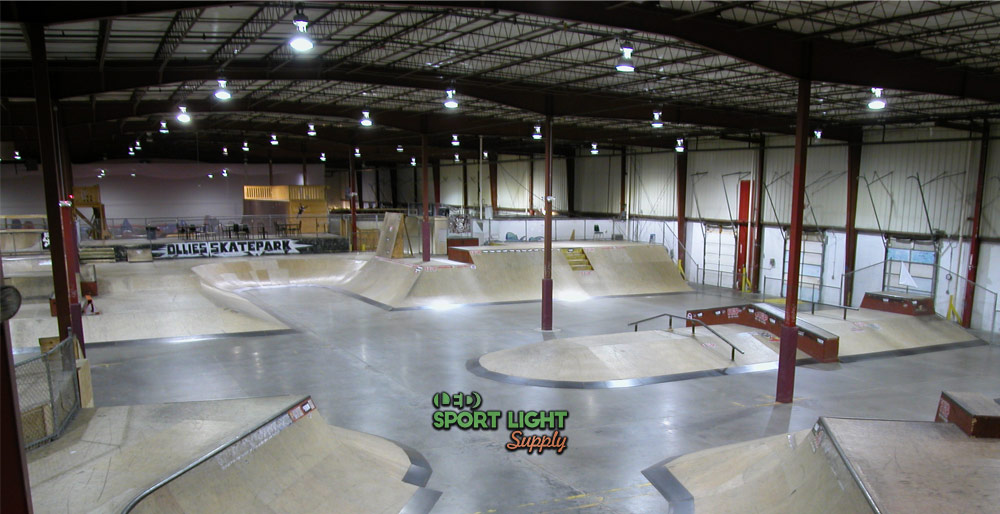
Lighting uniformity is crucial to ensure that all areas of the skate park receive consistent brightness, reducing shadows and improving safety. Proper distribution of light prevents significant differences in illuminance, allowing skaters to move smoothly across different sections of the park.
The lighting uniformity requirements are as follows:
| Use Case | Uniformity Ratio |
|---|---|
| Recreational Use | 0.4 to 0.6 |
| Competitions | 0.5 to 0.6 |
| Professional Events | At least 0.7 |
To calculate uniformity, take multiple lux readings across different parts of the park. Divide the minimum lux value by the maximum lux value to determine the uniformity ratio.
Glare-Free Lighting
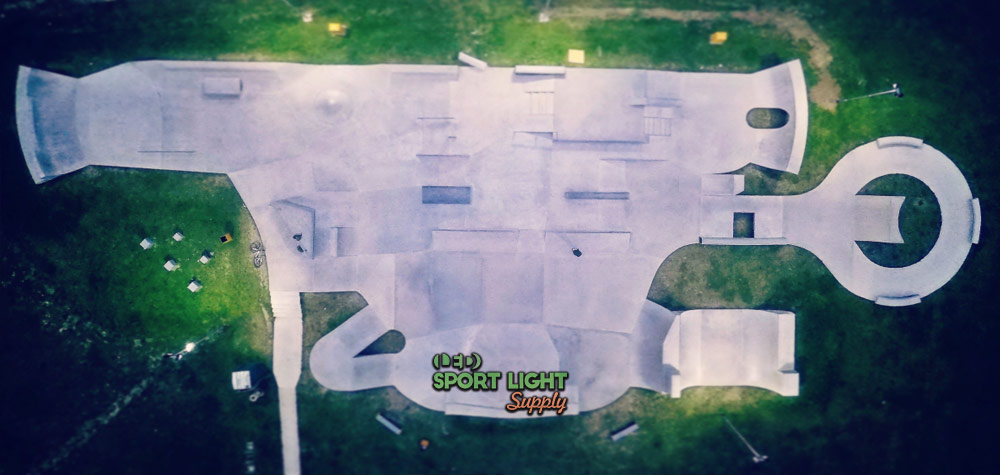
Glare from lighting equipment can impair visibility and cause discomfort for both skateboarders and spectators. To prevent glare, consider using glare shields, anti-glare accessories, or special optics.
For LED lights, reducing glare is particularly important as excessive brightness can lead to light pollution and visual discomfort. Some skateboarding events or associations may have specific glare rating requirements, so it’s advisable to check with event organizers.
Effective glare control also involves identifying and managing reflective surfaces. A photometric test can help determine the best shielding methods to minimize glare while maintaining fixture efficiency. Using LED diffusing lenses can improve uniformity but may reduce light efficiency.
Flicker-Free Lighting
Flicker-free lighting is essential for broadcasting and video recording. Flickering can cause undesirable lines and artifacts in footage, which is why it’s important to use flicker-free LED lights.
Flickering is often caused by subpar LED drivers or transformers that fail to convert alternating current (AC) to direct current (DC) cleanly. Modern LED lights are designed to prevent flicker regardless of camera movement. Consulting a professional lighting designer can help identify and replace outdated LED lights that may cause flickering.
To ensure your power supply is flicker-free, check the output voltage specifications. A flicker-free power supply will have clear indications or symbols on the label.
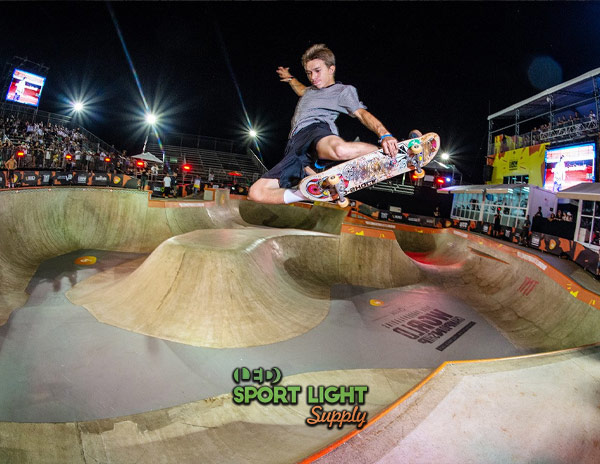
Color Rendering Index (CRI)
Color rendering is critical for accurate representation in broadcasts, streams, and photographs. The Color Rendering Index (CRI) measures how well a light source renders colors compared to natural sunlight.
For skateboarding events, a CRI value of more than 85 Ra is recommended. Most LED lights offer a CRI greater than 90, with some professional equipment featuring a Television Lighting Consistency Index (TLCI) rating, which is more precise for TV and video. A TLCI value above 90 provides excellent color rendering.
A high CRI value not only ensures accurate color representation but also creates a welcoming atmosphere for nighttime skateboarding, enhancing the overall experience.
Importance of Fulfilling the Lighting Requirements of the Skate Park
Enhanced Lighting Experience for Skateboarders
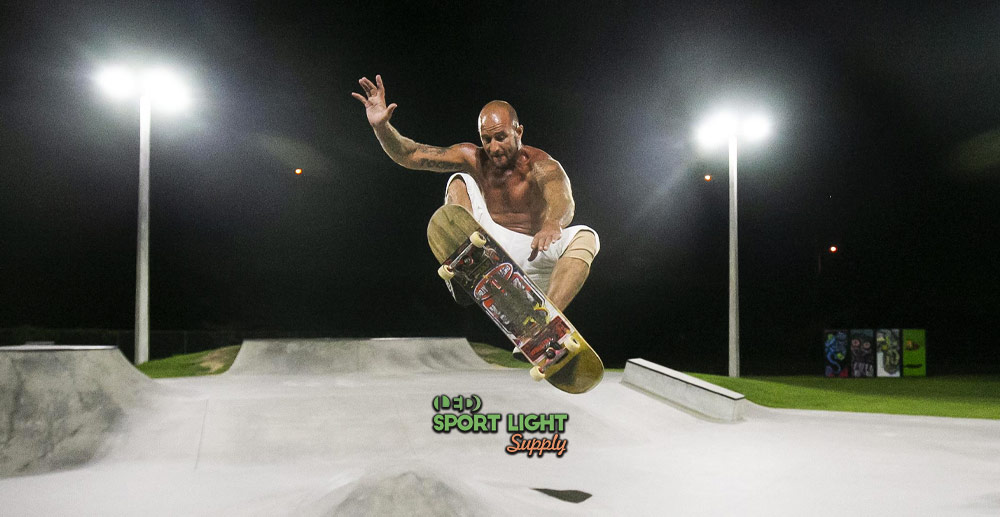
Effective lighting is crucial for skateboarders who rely on clear visibility to execute their tricks safely and accurately. Inadequate lighting can turn even simple maneuvers into challenging tasks. When a skate park is poorly lit, skateboarders may struggle to see the ramps and obstacles clearly, which can hinder their performance and even lead to errors.
Proper illumination allows skateboarders to see features like kickers and decks clearly, making it easier to plan and execute complex tricks such as double flips. Improved lighting not only boosts their performance but also enhances their overall experience, encouraging them to return for more practice and honing their skills.
Improved Viewing Experience for Skate Park Audiences
Skateboarding events captivate audiences who are drawn to the excitement and skill involved. Whether they are fans of the sport or appreciate the artistry of the tricks, good lighting plays a vital role in their enjoyment. High-quality lighting ensures that every move, grind, and flip is visible and engaging.
For spectators, well-designed lighting creates memorable experiences by enhancing their view of the action. In an era where live streaming and social media are prevalent, ensuring that the skate park is well-lit can help in creating shareable moments and attracting a larger audience. Engaging lighting design thus supports audience satisfaction and participation, making the event more enjoyable for everyone.
Optimal Conditions for Broadcasting
Broadcasting skateboarding events requires meeting specific lighting standards to ensure high-quality footage. Broadcasters rely on excellent lighting to capture clear and vibrant images, which can significantly impact TV ratings and viewer engagement. Adequate illumination provided by high mast lighting with LED fixtures ensures that every detail of the performance is visible and appealing.
By adhering to professional lighting standards, skate parks can attract broadcasting companies and other media outlets, leading to increased exposure and a stronger reputation. Upgrading to modern LED lights not only improves visibility but also enhances the overall aesthetic appeal of the skate park, making it more appealing to broadcasters and sponsors.
Conclusion
Meeting lighting requirements for a skate park is essential for optimizing the experience for skateboarders, audiences, and broadcasters. Proper lighting enhances performance, audience enjoyment, and broadcast quality, ultimately contributing to the skate park’s success and reputation. Upgrading to high-quality LED lights and ensuring adherence to lighting standards can transform the skate park environment, attracting more visitors and media attention.
